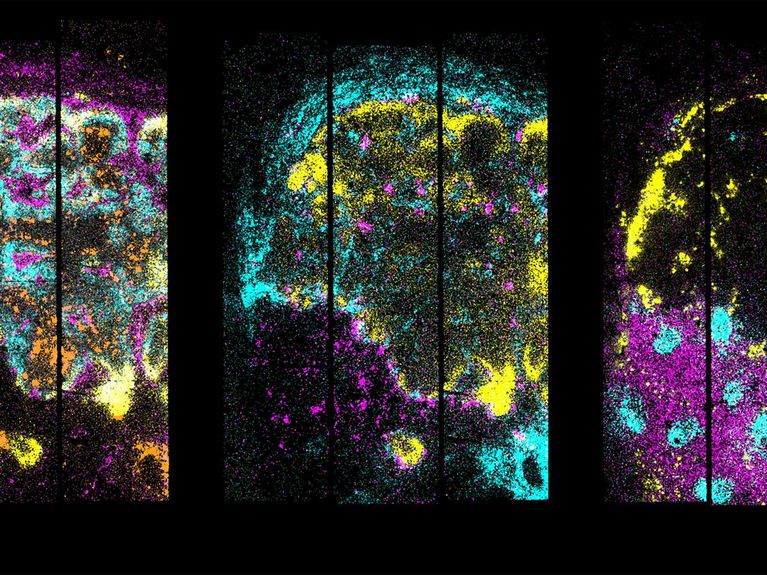
Story #14
AI for the Research of Tomorrow: The Foundation Model Initiative
Artificial Intelligence has the potential to provide answers to complex research questions. But to do so, its performance must be enhanced further. Accordingly, we’re developing models capable of analyzing huge amounts of data and intelligently combining different forms of information: Foundation Models.
From the ocean floor, from within nuclei, or from materials research: in our projects, we gather massive amounts of valuable data. To analyze that data, we use highly complex calculations – often with the support of Artificial Intelligence (AI) methods. Training AI models is a lengthy and resource-intensive process. Classic AI models are trained for a single research question, while a new generation, referred to as Foundation Models, pursue a broader approach. The best-known examples are Large Language Models (LLMs) like ChatGPT, which “understand” language well enough to also answer questions they were never trained on.
Our Helmholtz Centers are at the forefront of developing these models for research purposes: the programs analyze enormous amounts of data, identifying specific patterns and correlations in the process. As such, they can be used to advance complex research projects – more quickly and comprehensively than has ever been possible.
Through the Helmholtz Foundation Model Initiative (HFMI), our goal is to harness this tremendous potential for the good of research. The network brings together twelve Helmholtz Centers, which jointly develop cutting-edge Foundation Models. Their current focus is on seven pilot projects of major societal relevance – like medical cellular research and analyzing materials for photovoltaic systems.
In addition, a team with members from various research centers, the Synergy Unit, pursues research on cross-cutting issues so as to improve the models and optimize their training. The Unit also promotes the exchange of ideas between projects, helping them learn from one another, identify shared problems and challenges, and tackle them together.
The appeal of Foundation Models in research can be seen in the project AqQua: here, researchers from the Max Delbrück Center work closely together with experts from GEOMAR, Forschungszentrum Jülich, and Hereon. AqQua’s focus is on plankton – minuscule marine organisms that are key players in the global climate balance, as they bind huge amounts of CO2. But studies indicate they are under increasing pressure from climate change. In response, plankton are being investigated around the globe – yet we still know very little about their biodiversity. It also remains unclear how much CO2 the different species bind.
AqQua wants to close these gaps in our knowledge. To do so, the participating research centers are developing a Foundation Model that uses countless images of plankton – several billion individual data points gathered from around the world. AqQua will analyze the photographs and classify the species that can be seen in them. In this way, it will deliver a far more accurate overview of global plankton biodiversity – a biodiversity map, so to speak. The program will also yield new insights regarding the individual species’ CO2 turnover. As such, it will provide the scientific community with a powerful tool for monitoring global plankton stocks, one that can also be used to draw conclusions on the ecosystem’s health and carbon cycle.
AI is also used in health research. For example, teams from Helmholtz Munich, Jülich, and the Max Delbrück Center are now developing a Foundation Model that will use molecular data on individual tissue cells to identify the origins of cancer and more accurately diagnose disease. A project coordinated by the German Cancer Research Center (DKFZ) will apply a Foundation Model to map complex, 3D radiological data and improve decision-making in connection with diagnosis and treatment. Further projects in the initiative will focus on analyzing the carbon cycle, using AI to optimize climate models, and modelling proteins in motion.
As these examples show: Foundation Models can make vital contributions to answering fundamental research questions. As using these models is still a comparatively new approach, the HFMI’s goal is to gain a better understanding of the new methods, to adapt processes and structures so that larger and more comprehensive models can also be trained, and to provide basic and advanced training on their use.
Bild: AG N. Rajewsky, Max Delbrück Center
Participating centers
- AWI
Alfred Wegener Institute, Helmholtz Centre for Polar and Marine Research
- Jülich
Forschungszentrum Jülich
- Geomar
GEOMAR Helmholtz Centre for Ocean Research Kiel
- GFZ
GFZ Helmholtz Centre for Geosciences
- DLR
German Aerospace Center
- DKFZ
German Cancer Research Center
- UFZ
Helmholtz Centre for Environmental Research – UFZ
- Munich
Helmholtz Munich
- HZDR
Helmholtz-Zentrum Dresden-Rossendorf
- Hereon
Helmholtz-Zentrum Hereon
- KIT
Karlsruhe Institute of Technology
- MDC
Max Delbrück Center